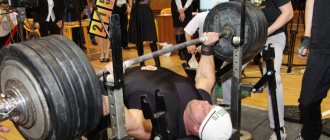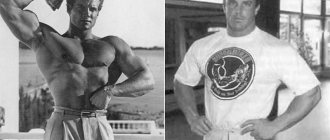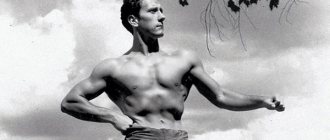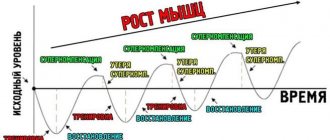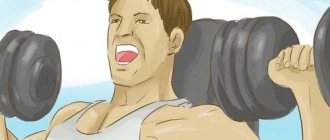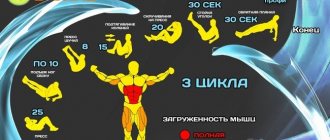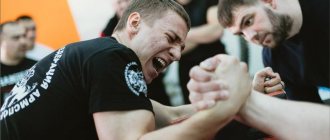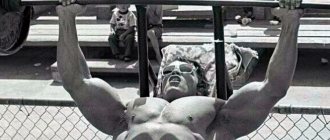The success of the workout depends not only on the correct technique of performing the exercises. We also need a competent program, where each movement helps in the development of a certain area of the body. If you want to get the most out of your classes, you will find a lot of interesting information in this article.
How to create a training program? There are different schools of thought as to what to look for and what exercises are best. But more about everything.
Content
- How long to train?
- Warm-up
- How to create a training program: basic principles
- Basic exercises
- How many approaches should you do?
- How many repetitions should I do?
- How long to rest between sets?
- How to choose a working weight?
- How to calculate the duration of a workout?
- A training program with alternating approaches and reducing rest between them.
- Circuit training program
- Cool down and its role in creating a training program
- Basic rules for creating a training program
Warm-up
A study was conducted in Norway: 1840 handball players were divided into 2 groups. Over the course of 8 months, one group warmed up before exercise, the other did not. According to the test results, in group 1 there were 2 times fewer injuries than in group 2. In addition, warm-up before exercise:
- stimulates the functioning of the cardiovascular system;
- improves blood flow;
- increases pulmonary ventilation and oxygen saturation of the body;
- increases body temperature and the speed of physiological reactions;
- increases the elasticity of ligaments;
- reduces pressure on articular cartilage;
- increases muscle endurance;
- increases attention and concentration.
According to the findings of scientists from the University of North Carolina, dynamic stretching in the pumping style is optimal for warming up - bodyweight squats, lunges, burpees. You should not include static stretching exercises in your warm-up - this reduces the effectiveness of the workout by 8.4%.
The intensity during the warm-up is increased gradually. Its duration is 5-10 minutes. The rest interval between warm-up and training should not exceed 5 minutes.
Goals and objectives
The purpose, objectives, means and methods of sports training is a topic that has been studied in detail for a long time. It would seem that there can be nothing new here, everything has been said and done a long time ago. But sport changes along with life and business. New approaches and technologies of sports training methods deserve attention and study not only from coaches.
The goal of any sports training is one: to ensure that the trained athlete achieves the highest possible level of fitness and the highest results in competitions. Of course, you always need to take into account the specifics of the sport and the conditions of external circumstances.
The objectives of sports training are a broad and varied concept, we present some of them:
- achieving the necessary volitional and moral qualities for further studies and competitions;
- mastering the main skills: tactics and techniques of a particular sport;
- development of the motor and functional capabilities of the athlete’s body, which bear the maximum load in the chosen sport;
- development of mental preparation to a given required level;
- mastering theory and practice in the sport;
- general improvement and preparation of the athlete for competitions.
The preparation of an athlete is not limited to such tasks. There are main directions, each of them has completely independent characteristics.
Basic exercises
- For quadriceps: lunges, squats on two and one legs, jumping on a platform.
- For hamstrings and glutes: bending over, glute bridges, deadlifts.
- Presses for triceps, shoulders and chest: dips, dips, incline presses, bench presses and overhead presses.
- Traction exercises for the forearm, biceps, back muscles: abdominal pull-downs, pull-ups on a low bar with a direct and reverse grip.
- For the core muscles - core stabilizers - lower back and abs: crunches on a fitball, “bicycle”, planks, including side planks, “climber”, hanging leg raises.
There are many more effective exercises for each muscle group, but for beginner athletes the ones listed are quite sufficient. If you perform one exercise from each category during each workout, you will work the major muscle groups of the entire body.
Remember the basic principle of building a training program: to constantly progress, change exercises periodically. This will help maintain performance and motivation, and the controlled surprise of the load will help build strength. For example, if you do bench press on Monday, do dips on Wednesday, and do standing press on Friday.
How many repetitions should I do?
In order to expend maximum calories when working muscles, perform 8-15 repetitions per approach. If you can easily perform more than 15 repetitions, then the exercise has become easy and ineffective for you: complicate the movements or increase the working weight.
Changing the number of repetitions works well for muscle growth. Use this when creating your own training program.
For example:
- Monday – heavy weight and few repetitions (5-8);
- Wednesday – light weight and many repetitions (12-15);
- Friday – average weight and average number of repetitions (8-12).
With this training scheme, the muscles adapt to a variety of loads, due to which they become larger and stronger.
Repeat ranges and their impact:
- A low rep range - from 1 to 5 - makes the muscles more dense and develops strength.
- The middle range—6 to 12—increases muscle mass and strength equally.
- Large – 13 and more – increases volume and develops strength endurance.
When you vary your rep ranges, you develop all the qualities and achieve a balance between power, strength and endurance.
To avoid a “plateau”—a stop in progress—the same exercise is performed in different ranges and the working weight is increased. Use this principle when building a self-training program in the gym.
For example, dumbbell bench press:
- 30 kg – 12 repetitions with rest 90 seconds;
- 32 kg – 10 repetitions with rest 90 seconds;
- 34 kg – 8 repetitions with rest 90 seconds;
- 36 kg - 6 repetitions.
They are based on a certain order of combining and regulating the load in the process of reproducing an exercise, or one or another way of ordering the actions of those involved and the conditions for their implementation.
The essence of a particular method of improving motor skills and the targeted development of motor abilities largely depends on the chosen method of regulating and dosing each of the load parameters: intensity of duration, number of repetitions of exercises, intervals and nature of rest.
The uniform method is characterized by the fact that physical exercise is performed continuously with a relatively constant intensity.
The intensity can be considered constant if its fluctuations do not exceed 3% of the average.
There are two variants of this method:
• method of long-term uniform training;
• method of short-term uniform training
The first option is characterized by performing work of low intensity for a long time. Energy supply to muscle activity is carried out through aerobic mechanisms of energy production, i.e. oxygen consumption corresponds to oxygen needs. Heart rate ranges from 130 to 180 beats/min. The duration of continuous operation can range from 15 to 90 minutes or more. This option helps improve the aerobic component of endurance.
In the second option, the work is more intensive. Its duration decreases. Exercises are performed in a mixed aerobic-anaerobic mode. It is used to educate and improve the sense of pace, as well as to develop the aerobic-anaerobic component of endurance.
The advantages of the uniform method are, first of all, that it makes it possible to perform a significant amount of work, helps to stabilize motor skills, increase the power of the heart, improve central and peripheral blood circulation in the muscles, the power of the external respiration apparatus and the endurance of the respiratory muscles, and improve the coordination of the work of internal organs and muscles. Long-term loads contribute to the development of strong-willed qualities in them: perseverance, perseverance, etc.
The disadvantages of the uniform method are the body’s rapid adaptation to it, which reduces the training effect. Continuous duration of work with constant intensity leads to the fact that over time a certain familiar standard tempo of movements is developed.
The alternating method is characterized by sequential variation of the load during the continuous execution of an exercise, by purposefully changing the speed of movement, tempo, rhythm duration, amplitude of movements, magnitude of effort, changing movement technique, etc.
An example of this would be changing running speed over a distance, the pace of play, and performing technical techniques in hockey during each period.
The training effect on the body of those involved when using the variable method is provided during the work period. The direction of influence on the functional properties of the body is regulated by changing the mode of operation and the form of movements.
The tasks solved using the alternating method are very diverse: developing speed capabilities and endurance (general and special), expanding the range of motor skills, increasing coordination of movements, acquiring certain tactical skills, and developing volitional qualities.
The alternating method is used in cyclic and acyclic exercises. In cyclic exercises, loads are mainly regulated by varying the speed of movement. It can vary from moderate to competitive. The nature of physiological changes in the body depends on varying the speed and duration of the exercise, which, in turn, leads to the development of aerobic or aerobic-anaerobic capabilities.
In acyclic exercises, the variable method is implemented by performing exercises that continuously change both in intensity and in the form of movements.
The repeated method is characterized by repeated exercises at rest intervals, during which a fairly complete restoration of performance occurs.
The use of this method provides a training effect on the body not only during the exercise, but also due to the summation of fatigue of the human body from each repetition of the task.
Problems solved by the repeated method: development of strength, speed and speed-strength capabilities, speed endurance, development of the necessary competitive tempo and rhythm; stabilization of high-speed movement techniques, mental stability.
This method is used in both cyclic and acyclic exercises. The intensity of the load can be: 75-95% of the maximum in this exercise, or near the maximum and maximum - 95-100%. The duration of the exercise may also vary. For example, in running, rowing, swimming, work is used in short, medium and long segments. The speed of movement is planned in advance, based on the personal record for this segment. Exercises are performed in series. The number of repetitions of exercises in each series is small and is limited by the ability of the trainees to maintain a given intensity (speed of movement, tempo of movements, amount of external resistance, etc.). Rest intervals depend on the duration and intensity of the load. However, they are installed in such a way as to ensure restoration of performance before the next repetition of the exercise.
In cyclic exercises, repeated work over short periods is aimed at developing speed abilities. At medium and long distances - speed endurance.
Moving with high intensity—in skating, walking, and other exercises over relatively long periods—helps develop a “sense of competitive pace” and improve movement technique. In this regard, the repeated method is sometimes called the repeated-tempo training method.
The nature of the energy supply during short-term work is mainly anaerobic, while during medium and long periods it is mixed, i.e. aerobic-anaerobic. In acyclic exercises (weightlifting, jumping, throwing), along with improving movement techniques, this method is used mainly to develop strength and speed-strength abilities.
The interval method is characterized by repeated repetition of the exercise at certain rest intervals.
The essence of this method is that during repeated execution, the intensity of a single load should be such that the heart rate by the end of the work is 160-180 beats/min. Since the duration of the exercise is usually short, oxygen consumption during exercise does not reach its maximum values. During the rest pause, despite the decrease in heart rate, oxygen consumption during the first 30 s increases and reaches its maximum. At the same time, the most favorable conditions are created for increasing the stroke volume of the heart. Thus, the training effect occurs not only and not so much at the time of performing the exercise, but during the rest period. Hence the similar name of this method.
Rest pauses are set in such a way that before starting the next repetition of the exercise, the pulse is in the range of 120-140 beats/min, i.e. Each new load is given at the stage of incomplete recovery. Rest can be active or passive, exercises are repeated in series. The series is terminated if, at the end of standard rest pauses, the heart rate does not fall below 120 beats/min. The total number of repetitions of exercises can be from 10-20 to 20-30.
The interval method has a number of options, which are based on various combinations of the components of the load (duration, intensity, number of exercises, etc.). Such diversity is associated with the solution of specific problems, the level of physical fitness, the health status of those involved, the type and nature of physical exercise. But the essence of the physiological effect in all these variants of the interval method remains approximately the same.
The circular method is the sequential performance of specially selected physical exercises that affect various muscle groups and functional systems, such as continuous or interval work. For each exercise, a location is designated, which is called a “station.” Usually there are 8-10 “stations” included in the circle. At each of them, the student performs one of the exercises (for example, pull-ups, squats, push-ups, jumping, etc.) and walks the circle 1 to 3 times.
This method is used to develop almost all motor abilities.
Game method. The basis of this method is plot-organized motor activity, which is based on the free choice of ways to achieve a goal and the satisfaction a person receives.
The gaming method is not necessarily associated with any generally accepted games, for example hockey, badminton, volleyball, but can be applied to any physical exercise (running, jumping, throwing, etc.), especially when conducting classes with preschool and school children age. It is a method of comprehensive improvement of a person’s physical and mental qualities. With its help, various tasks are solved: the development of motor abilities, the cultivation of courage, determination, resourcefulness, initiative, independence, tactical thinking, and the improvement of motor skills. The most characteristic features of the gaming method:
1. Pronounced rivalry and emotionality in game actions (the method allows you to model relatively complex relationships between people).
2. Extreme variability of the conditions of warfare and the conditions for carrying out actions.
3. High requirements for creative initiative in actions.
4. Lack of strict regulation in the nature of actions and workload.
5. Complex manifestation of various motor skills and abilities.
The disadvantages of this method include the limited possibility of dosing the load and forming a new, especially complex motor skill.
The competitive method is a way of performing exercises in the form of competitions. The competitive method is used to develop physical, volitional and moral qualities, improve technical and tactical skills. It can be used in elementary forms (for example, who will hit the target more accurately), in the form of semi-official or official competitions. This method, having much in common with the gaming method, differs in that it does not have a plot content.
Typically, the appropriateness of using this method depends on the type and nature of physical exercise, gender, age, physical fitness, health status, properties of the nervous system and temperament of those involved. The most characteristic features of the competitive method:
– subordination of all activities to the task of winning in accordance with the rules;
– stimulation of maximum manifestations of motor and personal capabilities and qualities, identifying the level of their development;
– ensuring maximum physical and mental stress.
But it must be remembered that the competitive method provides relatively limited opportunities for dosing the load and for directly managing the activities of those involved.
How to choose a working weight?
The correct working weight is the one with which you will perform the required number of repetitions and by the end of the set you will have no strength left. It is determined in practice by trial and error.
If you are a beginner athlete or learning a new exercise, perform the movements carefully and do not go all out. If you only do bodyweight exercises, make them more difficult as your form improves.
For example, if you find it easy to do 20 squats, do squats on one leg. This way, you will constantly increase the intensity of your training and improve your training program.
Combined training method
Fartlek
A unique version of the combined training method is fartlek (a game with elements of running on terrain). This method includes warm-up elements, walking, running (jogging, short distances, at variable speeds for long distances), various accelerations, etc. The appeal of fartlek is its ability to easily vary the load, which allows it to be used by both beginners and experienced runners. With this training method, running is performed continuously, but at a constantly changing speed (from low to medium and high, and then again to low, etc.).
How to calculate the duration of a workout?
The optimal training time is from 45 minutes to 1 hour:
- 5-10 minutes warm-up;
- 15-25 working sets;
- stretching exercises.
If you work out longer and still have energy left, then you are not training hard enough.
If you cannot devote 45 minutes to training, use one of the following techniques:
A training program with alternating approaches and reducing rest between them.
For example, let's say you planned 4 sets of dumbbell bench presses and 4 sets of squats. If you rest for 2 minutes between sets, then everything will take ~20 minutes.
Instead, use the rotation principle in your training program: do a set of presses, rest for 1 minute, and start squats. After them, again a minute of rest and again presses. This way, you will work one muscle group while others rest. This will save time and also increase your cardio load.
A training plan might look like this:
- 4 sets of incline bench presses, alternating with 4 sets of lunges, intervals between sets – 1 minute;
- 4 sets of wide-grip pull-ups, alternating with 4 sets of straight-legged deadlifts, 1 minute intervals between sets;
- 3 sets of planks;
- stretching.
Circuit training program.
Allows you to lose weight faster, since calories will be “burned off” after exercise. A circuit consists of sets of different exercises performed without pause. Each circle can be repeated 2-3 times.
An example of a home circuit training program for beginners:
- walking lunges - 20 repetitions;
- push-ups – 10 repetitions;
- squats without weights - 20 repetitions;
- One-arm dumbbell rows – 10 repetitions;
- jumping with legs apart and arms raised - 30 repetitions;
- plank – 15 seconds.
An example of a circuit training program in the gym:
- lunges - 12 repetitions;
- squats with a kettlebell - 12 repetitions;
- dumbbell bench press on an incline bench - 12 repetitions;
- barbell curls for biceps – 12 repetitions;
- arm extension on a cable-handle block – 12 repetitions;
- lifting dumbbells through the sides - 12 repetitions;
- pull-ups on the machine - 12 repetitions;
- jumping rope – 1 minute.
Cool down and its role in creating a training program
Cool down – transition to a calm state after training. Helps the body restore functions:
- reduces muscle tension;
- normalizes breathing, pulse, temperature, pressure and other indicators;
- intensively removes metabolic products such as lactic acid.
Regular recovery through cool-downs promotes muscle growth and progress in training skills. Their duration is 5-10 minutes. Working pulse – no more than 120 beats per minute.
Optimal for inclusion in the training program are static stretching exercises, exercises on bicycle and elliptical trainers, and treadmills. For self-massage you can use the Foam Roller. At the end of the cool-down, you can go to the sauna or bathhouse.
Record your progress in each exercise - increasing the working weight, doing more repetitions, etc. - in your training diary. It will help you analyze actions and results and correctly create a training program that will be optimal for you.
Game method of training
The game method of training reflects the methodological features of the game and is a method of comprehensive improvement of endurance. The method is characterized by broad independence in the actions of trainees, high demands on their initiative, resourcefulness, and motor creativity. The “plot” and rules of the game, outlining only a general line of behavior, leave great opportunities for creative solution of motor problems, and the constant and sudden change of situations during the game obliges to solve these problems in the shortest possible time and with full mobilization of motor abilities. The game method seems especially suitable for acquiring such social qualities as the ability to work in a team and the desire to help a colleague, the ability to cooperate, the ability to behave in conflict situations, etc. It is this method that allows solving problems related to the social education of the individual. However, the variety of ways to achieve the goal, the dynamism of actions, only in general terms directed by the “plot”, exclude the possibility of accurately regulating the load according to the degree of impact. Of course, this does not mean that the load in the game cannot be dosed at all. The game load is partly regulated by the rules of the game, the instructions of the coach and other indirect ways. But the accuracy of the dosage will always be significantly less than that of the training methods described above. Material from the site https://wikiwhat.ru
As a result, we highlight the basic rules for drawing up a training program:
- Train 2-3 times a week. Recover between workouts for 1-3 days.
- Always do a warm-up.
- Perform 1 exercise for each of the main muscle groups.
- Do 3-5 working approaches.
- Determine experimentally the number of repetitions and the duration of rest pauses between them.
- Vary the exercises from each category, change the number of repetitions, approaches and working weights.
- Increase your cardio load and workout intensity through circuit training.
- Try to stay within 1 hour.
- Do some stretching at the end of your session.
- Record your achievements in your training diary.
Rate this article:
Rating 4.74 [31 vote(s)]
Endurance techniques
- Interval method
Here the intervals between work and rest alternate. Rest time is strictly regulated. An excellent example of using the method in fitness is cardio interval training, which is recommended only for athletes with good physical fitness. The duration of rest can be determined in the range from a few seconds to three minutes, everything depends on the duration of the main part of the exercise - intense load.
In elite sports, series for the development of special endurance are extremely popular: for runners 400 m x 10 or for rowers 1000 m x 10.
For sprinters, their own schemes are used: 60 m x 3 are run at maximum speed, followed by a rest for five minutes; 30 m at maximum speed, then 200 m of slow running.
A progressive option is a gradual increase in load or range of motion. For example, running along segments of increasing length, or running along identical segments, but with increasing speed.
The descending option includes a decreasing load; swimmers love to use it. In this case, the length of the segments decreases with a simultaneous increase in swimming speed.
- Repeat method
A favorite method of bodybuilders, in which after a given number of repetitions there is a rest until energy resources are completely restored. In elite sports, this method is used to prepare an athlete for competitions - this is a good model of competitive loads.
- Circuit training method
A great way to build endurance through continuous exercise. Everything is done seamlessly and without interruptions with several repetitions of the complex in a circle. The advantage of the method is also its main feature: there is a gradual increase in load with a simultaneous increase in the power of working movements.
In bodybuilding, circuit training is included in the program during the “drying” stage to increase calorie consumption.
